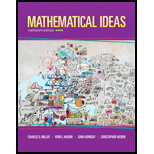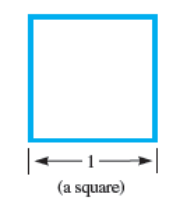
Concept explainers
Exercises 1-25 are taken from an issue of Student Math Notes, published by the National Council of Teachers of Mathematics. They were written by Dr. Tami S. Martin, Mathematics Department, Illinois State University, and the authors wish to thank N.C.T.M. and Tanti Martin for permission to reproduce this activity. Because the exercises should be done in numerical order, answers to all exercises (both even- and odd-numbered) appear in the answer section of the student edition of this text. Most of the mathematical objects you have studied have dimensions that are whole numbers. For example, such solids as cubes and icosahedrons have dimension three. Squares, triangles, and many other planar figures are two-dimensional. Lines are one-dimensional, and points have dimension zero. Consider a square with side of length one. Gather several of these squares by cutting out or using patterning blocks.

The size of a figure is calculated by counting the number of replicas (small pieces) that make it up. Here, a replica is the original square with edges of length one.
What is the least number of these squares that can be put together edge to edge to form a larger square?
The original square is made up of one small square, so its size is one.

Want to see the full answer?
Check out a sample textbook solution
Chapter 9 Solutions
Mathematical Ideas (13th Edition) - Standalone book
Additional Math Textbook Solutions
Finite Mathematics for Business, Economics, Life Sciences and Social Sciences Plus NEW MyLab Math with Pearson eText -- Access Card Package (13th Edition)
Probability and Statistics for Engineers and Scientists
Finite Mathematics & Its Applications (12th Edition)
MATH IN OUR WORLD (LOOSELEAF)-W/ACCESS
Thinking Mathematically (6th Edition)
- A Bitter Dispute With the publication of Ars Magna, a dispute intensified between Jerome Cardan and another mathematician named Niceolo Fontana, otherwise known as Tartaglia. What was the dispute, and how did it arise? In your opinion, who was at fault? Write a paragraph or two about your findings.arrow_forwardRead the following prompt and complete the subquestions 3.a, 3.b, and 3.carrow_forwardIn a researcher’s action research, she seeks to investigate whether a particular intervention works for teaching a mathematical concept. She organizes a diagnostic test (pre-test), taught with her intervention and then did a post-test. The recorded scores for ten students is in the table below: Student ID 01 02 03 04 05 06 07 08 09 10 Pre-test 66 49 63 70 71 65 75 88 87 51 Post-test 69 50 61 72 78 66 75 89 86 54 I. Draw a scatter plot for the observed scores and superimposed in it a least square regression line. ii. Compute the pearson product moment coleration for the two test and interpret your results.arrow_forward
- A polling company reported that 59% of 1013 surveyed adults said that rising gas prices are "quite annoying." Complete parts (a) through (d) below. The exact value is . (Type an integer or a decimal.) b. Could the result from part (a) be the actual number of adults who said that rising gas prices are "quite annoying"? Why or why not? O A. Yes, the result from part (a) could be the actual number of adults who said that rising gas prices are "quite annoying" because the polling numbers are accurate. O B. No, the result from part (a) could not be the actual number of adults who said that rising gas prices are "quite annoying" because that is a very rare opinion. O C. No, the result from part (a) could not be the actual number of adults who said that rising gas prices are "quite annoying" because a count of people must result in a whole number. O D. Yes, the result from part (a) could be the actual number of adults who said that rising gas prices are "quite annoying" because the results…arrow_forwardIn 2004 it surfaced in Reader's Digest presented as having happened to a teacher at an unnamed community college. Four students walked in halfway through American history test my father was giving at the local community college. "Sorry," they said, "we had a flat tire." An understanding man, Dad said that if they could answer just one question correctly, he would give them each an "A" for the exam. The students agreed. So my father handed each one a piece of paper, placed them in four separate comers and said, "Write down which tire was flat." Kurt Smith What is the probability that these four students would give identical answers if they hadn't had a flat tire? Why?arrow_forwardQuestion 4 I have a habit of getting up before the sun rises. My socks are all mixed up in the drawer, which contains 20 blue and 18 black socks. I reach into the drawer and grab some socks in the dark. How many socks minimum do I need to take from the drawer to be sure that I have a matched pair? (A) 18 socks B) 21 socks C) 2 socks (D) 3 socks E 19 socksarrow_forward
- Researchers wanted to determine if there was an association between daily cantaloupe consumption and the occurrence of high cholesterolhigh cholesterol.The researchers looked at 93 comma 17393,173 women and asked them to report their cantaloupe-eatingeating habits. The researchers also determined which of the women had high cholesterolhigh cholesterol. After their analysis, the researchers concluded that consumption of two or more servingstwo or more servings of cantaloupecantaloupe per day was associated with a reduction in high cholesterolhigh cholesterol. Complete parts (a) through (c) below. (a) What type of observational study was this? Explain. A. This was a cross-sectional study because all information about the individuals was collected at a specific point in time. B. This was a cohort study because it identified a group of individuals to participate in the study and observed the group over a long period of time. C. This was a case-control study…arrow_forwardD and E onlyarrow_forwardUse the following table below to answer the 5 (five) questions below: Gender / Student Type Under-graduate Graduate Male 100 460 Female 240 200 Required Tasks: (a) P (Male) (b) P (Under graduate) (c) P (Male OR under graduate) (d) P (Female AND Under graduate) (e) P (Graduate | Female)arrow_forward
- it is all in one questionarrow_forwardJeff Friedman was a section chief for an electric utility company. After the numbers in one of his reports to the management of the utility didn't add up, he was reassigned to the home economics department. He interviewed 119 people in a suburban shopping center to discover some of their cooking habits. He obtained the results shown to the right. 53 use microwave ovens; 63 use electric ranges; 52 use gas ranges; 23 use microwave ovens and electric ranges; 20 use microwave ovens and gas ranges; 8 use both gas and electric ranges; 2 use all three; 4 uses none of the three. Should he be reassigned one more time? Why or why not? Select the correct choice below and, if necessary, fill in the answer box to complete your choice. A. Yes, he should be reassigned. He says that he interviewed 119 people, but the numbers in his report indicate that he actually interviewed some error, he should be reassigned. people. Since he made B. No he should not be reassigned. He says that he interviewed 119…arrow_forwardSuppose that you read through this year's issues of the New York Times and record each number that appears in a news article-the income of a CEO, the number of cases of wine produced by a winery, the total charitable contribution of a politician during the previous tax year, the age of a celebrity, and so on. Now focus on the leading digit of each number, which could be 1, 2, ..., 8, or 9. Your first thought might be that the leading digit X of a randomly selected number would be equally likely to be one of the nine possibilities (a discrete uniform distribution). However, much empirical evidence as well as some theoretical arguments suggest an alternative probability distribution called Benford's law, given below. x + 1 x = 1, 2, ..., 9 P(x) = P(1st digit is x) = log,o (a) without computing individual probabilities from this formula, show that it specifies a legitimate pmf. x+ : ? v1 for all x = 1, ..., 9, so log,o ? v 0. x + 1 First, Next, check that the probabilities sum to 1. lo910…arrow_forward
 Trigonometry (MindTap Course List)TrigonometryISBN:9781305652224Author:Charles P. McKeague, Mark D. TurnerPublisher:Cengage Learning
Trigonometry (MindTap Course List)TrigonometryISBN:9781305652224Author:Charles P. McKeague, Mark D. TurnerPublisher:Cengage Learning
 Algebra: Structure And Method, Book 1AlgebraISBN:9780395977224Author:Richard G. Brown, Mary P. Dolciani, Robert H. Sorgenfrey, William L. ColePublisher:McDougal Littell
Algebra: Structure And Method, Book 1AlgebraISBN:9780395977224Author:Richard G. Brown, Mary P. Dolciani, Robert H. Sorgenfrey, William L. ColePublisher:McDougal Littell- Algebra & Trigonometry with Analytic GeometryAlgebraISBN:9781133382119Author:SwokowskiPublisher:Cengage



